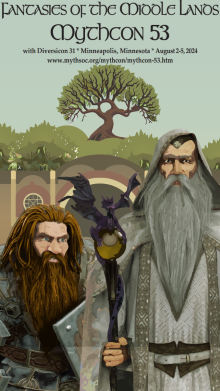Loading...
Location
Minneapolis, Minnesota
Document Type
Presentation
Event Website
https://www.mythsoc.org/mythcon/mythcon-53.htm
Start Date
3-8-2024 2:30 PM
End Date
3-8-2024 3:20 PM
Description
The middle sections of a story can afford readers opportunities to appreciate different aspects of a work than the beliefsuspending beginnings or resolution-providing endings. Professor Tolkien’s The Lord of the Rings is no exception. It is set in the “middle times” of his larger legendarium—the Third Age tension with Elves in exile and men guiding the world. Moreover, the middle portion of The Lord of the Rings, The Two Towers, highlights a tension between free will and fate that underlies the entire narrative. Focalization via the characters of Samwise Gamgee and Sméagol draws the reader into that central tension. Specifically, Tolkien’s use of focalization, which may seem happenstance and merely a byproduct of the story’s progression, shifts the lens through which readers encounter the story’s pivotal decisions. Such shifts have led some to call Sam or Sméagol 19 the true hero(s) of Tolkien’s story. Or, at least, the possible heroes most worthy of readers’ careful study. And careful study can properly frame Samwise’s reflections about heroes “landed in” great tales, “lots of chances of turning back,” as well as the story’s final words: “Well, I’m back.” This article will survey the “middle-ness” of the Third Age of the world, “middle-ness” of The Two Towers, and “middle-ness” of choices made by Samwise and Sméagol. And this article will conclude that the “middleness” illustrates how readers can rejoice alongside the hobbits that they are “only quite [little fellows] in a wide world,” and that “all we have to decide is what to do with the time that is given us.”
Creative Commons License

This work is licensed under a Creative Commons Attribution-NonCommercial-No Derivative Works 4.0 International License.
Included in
Samwise and Sméagol: Narrative Shift and Personal Choice in The Two Towers
Minneapolis, Minnesota
The middle sections of a story can afford readers opportunities to appreciate different aspects of a work than the beliefsuspending beginnings or resolution-providing endings. Professor Tolkien’s The Lord of the Rings is no exception. It is set in the “middle times” of his larger legendarium—the Third Age tension with Elves in exile and men guiding the world. Moreover, the middle portion of The Lord of the Rings, The Two Towers, highlights a tension between free will and fate that underlies the entire narrative. Focalization via the characters of Samwise Gamgee and Sméagol draws the reader into that central tension. Specifically, Tolkien’s use of focalization, which may seem happenstance and merely a byproduct of the story’s progression, shifts the lens through which readers encounter the story’s pivotal decisions. Such shifts have led some to call Sam or Sméagol 19 the true hero(s) of Tolkien’s story. Or, at least, the possible heroes most worthy of readers’ careful study. And careful study can properly frame Samwise’s reflections about heroes “landed in” great tales, “lots of chances of turning back,” as well as the story’s final words: “Well, I’m back.” This article will survey the “middle-ness” of the Third Age of the world, “middle-ness” of The Two Towers, and “middle-ness” of choices made by Samwise and Sméagol. And this article will conclude that the “middleness” illustrates how readers can rejoice alongside the hobbits that they are “only quite [little fellows] in a wide world,” and that “all we have to decide is what to do with the time that is given us.”
https://dc.swosu.edu/mythcon/mc53/schedule/16


